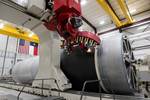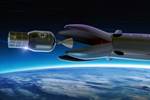Rocket Lab begins installation of large AFP machine for rocket production
The 99-ton AFP machine, custom-designed and built by Electroimpact, is claimed to be the largest of its kind, expecting to save around 150,000 manufacturing hours in the Neutron rocket’s production process.
Source | Rocket Lab USA
(Long Beach, Calif., U.S.), a global launch services and space systems company, has begun installation of what it claims is the largest automated fiber placement (AFP) machine of its kind into the company’s Neutron rocket production line in Middle River, Maryland. The AFP machine will enable Rocket Lab to automate production of the largest carbon fiber composite rocket structures in history.
The custom-built 99-ton, 12-meter-tall robotic machine, made by Electroimpact (Mukilteo, Wash., U.S.), has just completed final acceptance testing with the manufacturer and installation has begun at Rocket Lab’s Space Structures Complex in Middle River. The new machine will automate the production of all large composite structures of the Neutron launch vehicle, including the panels that make up the 28-meter-length interstage and fairing, 7-meter-diameter first stage and the 5-meter-diameter second stage tank.
The autonomous machine can move up to 30 meters in length and lay down continuous carbon fiber at a rate of 100 meters per minute. The AFP machine also has a fully automated real-time inspection system that hunts for minuscule defects throughout the carbon fiber laminate and alerts the machine operator of any issues before the machine begins laying down the next layer, providing additional assurance that these critical structures meet Rocket Lab’s high-quality standards required for reusable Neutron launches.
As Neutron’s composite structures move into full-scale production, this autonomous machine is expected to introduce significant time savings of 150,000+ manufacturing hours into the production process.
“As we build the world’s largest carbon [fiber] composite rocket, it makes sense that we require a world-first carbon [fiber] composite fiber placement machine,” Rocket Lab founder and CEO, Sir Peter Beck, says. “We’re combining our proprietary flight-proven carbon [fiber] composite technology, additive manufacturing and autonomous robotics to design and build large-scale aerospace components at a pace that will support not only Neutron’s launch cadence, but support Electron and carbon [fiber] composites structures for our spacecraft customers, too. We worked closely with our partners at Electroimpact to create this robot.”
The AFP machine will also be leveraged to print smaller carbon fiber composite Neutron structures, first stages of Rocket Lab’s Electron launch vehicle and other flight-proven composite structures for space including spacecraft structural panels and assemblies, solar panel substrates, carbon composite tanks and primary structures, and custom projects for the aerospace industry.
Related Content
-
Carbon fiber satellite arm reduces weight, simplifies assembly onto naval vessels
Satcom developer EM Solutions partnered with ACS Australia to replace an aluminum arm design with a 65% lighter, one-piece, corrosion-resistant carbon fiber/epoxy alternative.
-
Post Cure: Parallel winding technique demonstrates CFRP anisogrid design optimization
Over the years, CIRA has demonstrated its patented CFRP parallel winding technique in a variety of ways for space applications. The lattice structure for the Vega-C launcher stage is a prime example.
-
Revolutionizing space composites: A new era of satellite materials
A new approach for high volumes of small satellite structures uses low-CTE, low-cost CFRP cellular core, robust single-ply skins and modular panel systems to cut lead time, labor and cost for reflectors, solar arrays and more.






